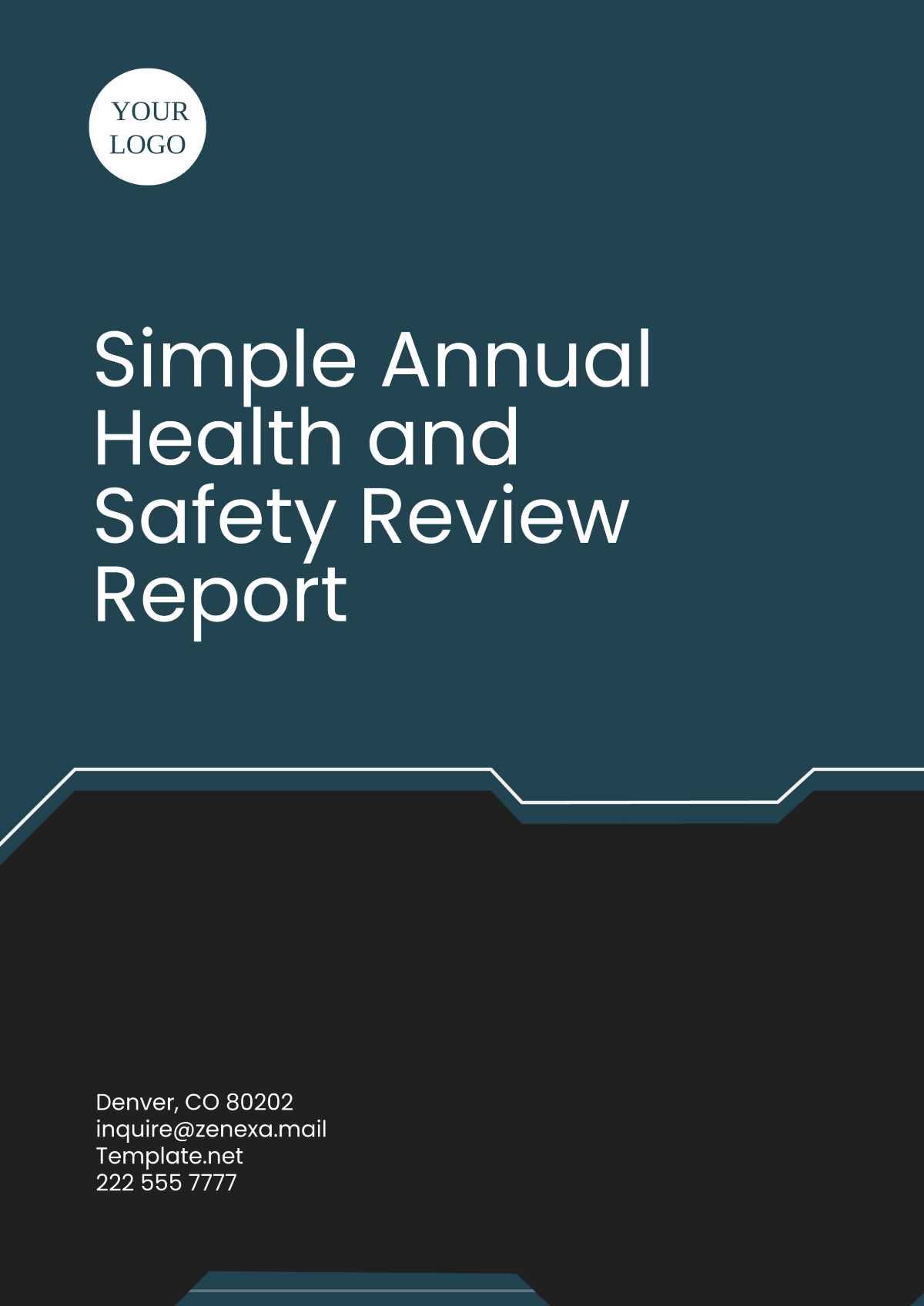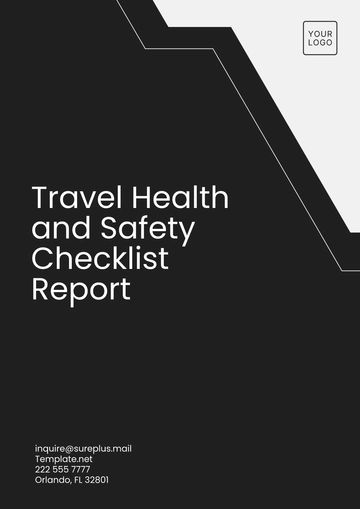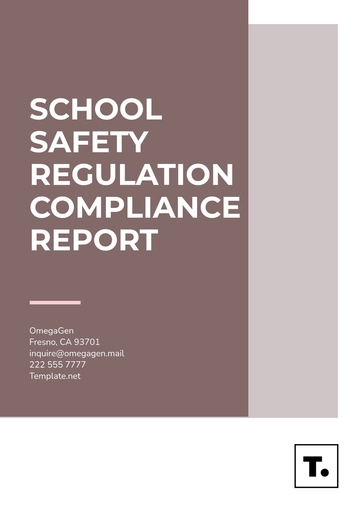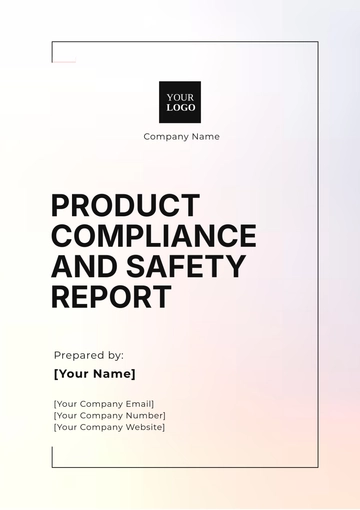Simple Annual Health and Safety Review Report
Prepared by: [Your Name]
Company: [Your Company Name]
Date: January 15, 2060
1. Introduction
The Annual Health and Safety Review Report offers an in-depth assessment of the safety practices, health protocols, and risk management strategies implemented throughout the past year. This report serves as a comprehensive review of the measures in place to protect employees, identify potential hazards, and enhance the overall health and safety culture. It aims to highlight successes, outline areas of concern, and present actionable strategies to ensure a safe and supportive work environment for all stakeholders.
2. Executive Summary
This section provides a concise summary of the major findings, achievements, and challenges identified during the health and safety review. Key successes, such as the reduction in incident rates or improvements in compliance, are highlighted alongside the challenges faced in upholding safety standards. The section also summarizes the recommendations for future improvements to foster a safer workplace.
3. Objectives of the Health and Safety Review
The primary goals of this annual review are to:
Evaluate the effectiveness of existing health and safety measures in reducing workplace risks.
Identify potential hazards and emerging risks to prevent future incidents.
Ensure compliance with local, national, and industry-specific health and safety regulations.
Promote a culture of safety across all levels of the organization through training and engagement.
Provide recommendations for continuous improvement and the adoption of best practices in safety management.
4. Health and Safety Performance Overview
This section reviews the overall health and safety performance over the year, including accident and incident trends, employee health surveillance, and the effectiveness of implemented safety initiatives.
4.1 Accident and Incident Analysis
An in-depth analysis of accidents and incidents reported during the year reveals trends and areas requiring attention. This section uses data to identify key areas where preventive measures can be improved.
Incident Type | Number of Incidents | Severity Level |
|---|
Slips, Trips, and Falls | 15 | Moderate |
Manual Handling Injuries | 10 | Low |
Workplace Violence | 2 | High |
Vehicle-related Incidents | 5 | Moderate |
Exposure to Hazardous Materials | 3 | High |
4.2 Health Surveillance
Regular health surveillance activities were conducted to monitor the well-being of employees and identify potential occupational health risks. Key health surveillance initiatives included:
Annual medical check-ups for high-risk job functions.
Exposure assessments for hazardous materials and environmental factors.
Mental health support programs to address the psychological well-being of employees.
5. Safety Initiatives and Programs
5.1 Training and Development
A critical component of our safety strategy is ongoing training and development. The following training programs were conducted throughout the year:
Fire Safety and Evacuation Procedures: Ensuring employees understand emergency protocols.
First Aid and CPR Certification: Equipping employees with the necessary skills to respond to medical emergencies.
Ergonomic Best Practices: Addressing common workplace musculoskeletal injuries.
Hazard Communication Standards: Educating employees about chemical safety and handling.
5.2 Risk Assessment and Management
Comprehensive risk assessments were performed across all departments to evaluate potential workplace hazards. These assessments focused on:
Equipment and machinery safety: Evaluating the safety of machinery and tools.
Work environment: Assessing workplace layout, lighting, ventilation, and ergonomics.
Work practices: Reviewing workflows to identify unsafe practices or procedures that could lead to incidents.
5.3 Incident and Near-Miss Reporting System
A robust reporting system was implemented to capture not only incidents but also near-miss situations, allowing for proactive risk mitigation. Data from this system helps in continuously refining safety practices and identifying areas for improvement.
6. Compliance and Regulatory Overview
6.1 Adherence to Regulations
We have maintained rigorous compliance with all relevant health and safety laws and regulations, including:
Local Occupational Health and Safety Standards
National Workplace Safety Laws
Industry-specific Safety Regulations
Regular audits and inspections were conducted to ensure full compliance, with any non-compliance issues promptly addressed and rectified.
6.2 Regulatory Body Engagements
The company actively engaged with regulatory bodies and conducted external audits to verify that all safety protocols aligned with industry standards. Key activities included:
Participation in industry forums and workshops on emerging safety regulations.
Collaboration with external auditors to assess compliance levels and implement recommended changes.
7. Challenges and Recommendations
7.1 Key Challenges
Several challenges were identified throughout the year that need to be addressed:
Increased absenteeism due to industrial injuries, affecting productivity.
Inconsistent safety practices across departments and shifts, lead to gaps in overall safety standards.
Decreased employee engagement in safety programs, with some employees not actively participating in safety training or initiatives.
7.2 Recommendations
To overcome the identified challenges, the following strategies are proposed:
Improve communication: Increase the frequency and diversity of communication around safety, including regular safety newsletters, team safety briefings, and the introduction of safety champions in each department.
Incentivize safety engagement: Implement a reward and recognition system for employees who actively engage in safety programs or demonstrate leadership in safety matters.
Enhance safety culture: Increase the frequency of refresher courses, conduct more interactive training sessions, and establish a safety committee with representatives from each department to promote a sense of ownership in safety efforts.
Strengthen injury prevention: Focus on ergonomics and safe manual handling techniques through specialized workshops and incorporate technology-driven solutions like wearable safety devices to monitor and prevent injury risks.
8. Employee Wellness Programs
Recognizing that health and safety extend beyond physical hazards, the company implemented various wellness programs, including:
Mental Health Support: Employee Assistance Programs (EAPs) offering confidential counseling services and mental health support resources.
Wellness Challenges: Organizing health-related challenges such as walking challenges, mindfulness programs, and stress management workshops.
Work-Life Balance Initiatives: Policies promoting flexible working hours, telecommuting, and adequate time off to prevent burnout.
9. Conclusion
The Annual Health and Safety Review Report underscores the company’s continued commitment to the health, safety, and well-being of its employees. Despite some challenges, significant progress has been made in strengthening the safety culture, improving compliance, and reducing incidents. Moving forward, the organization will continue to implement the proposed recommendations to elevate safety standards, ensuring the workplace remains a safe, healthy, and supportive environment for all employees.
By adhering to these recommendations, the company will not only comply with health and safety regulations but also foster a culture where employee well-being is prioritized, leading to a more productive, engaged, and safe workforce.
Report Templates @ Template.net






























